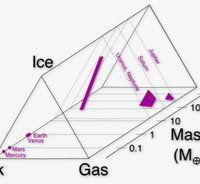
Sub-Neptune and super-Earth sized planets are a new planet category. They account for 80% of the planet candidates discovered by Kepler, and 0% of the planets in the Solar System. What is the nature of these sub-Neptune-size planets, how did they form, why are they so numerous, and could they support liquid water oceans? Dr. Rogers will review some highlights from the complement of exotic sub-Neptune-size planets discovered to date and will present an updated planet mass-radius diagram. With planet interior structure models, she will constrain the masses and radii both of rocky planets and of volatile-rich planets harboring liquid water oceans. These insights into the size demographics of rocky and volatile-rich planets have important implications for the occurrence rate of habitable planets throughout the galaxy.
 Getting Under Europa’s Skin
Getting Under Europa’s Skin Tracing Formation and Evolution of Outer Solar System Bodies Through Stable Isotopes and Noble Gas Abundances
Tracing Formation and Evolution of Outer Solar System Bodies Through Stable Isotopes and Noble Gas Abundances Photosynthesis, a Planetary Revolution
Photosynthesis, a Planetary Revolution Xenon: King of the Gases
Xenon: King of the Gases